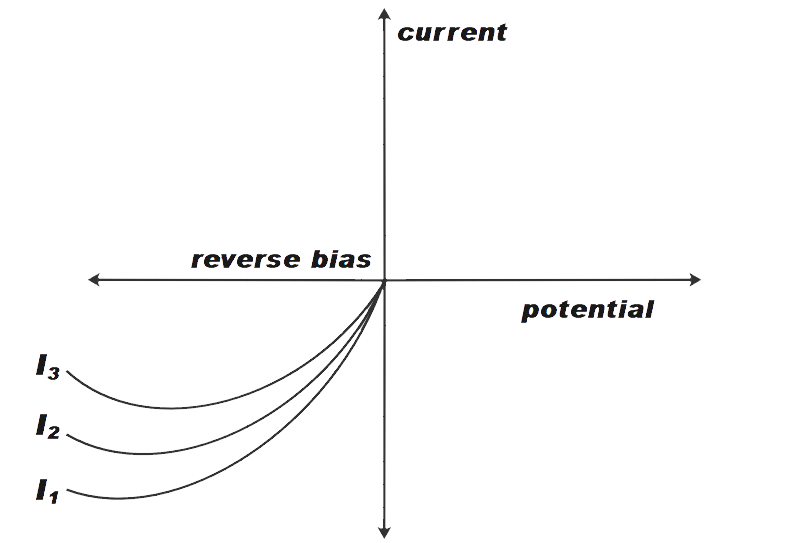
Plot V – I characteristics for an illuminated photodiodes under reverse bias for three different illumination intensities \[{{I}_{1}}\] > \[{{I}_{2}}\]> \[{{I}_{3}}\].
Answer
570.9k+ views
Hint: In this question we have been asked to plot the graph of V – I characteristics for different illumination intensities. To solve this question, we will be discussing what photodiodes are and also define the illumination intensities. We will also discuss what illumination intensities are. We will discuss the factors on which V – I characteristics of intensities depend.
Complete step by step answer:
Photo diode is a semiconductor device. It is used to convert light into an electric current. In a photodiode, the current is generated when the photons emitted are absorbed in the diode. The electron hole pair is generated when the reverse biased photodiode is illuminated with light of energy greater than the forbidden energy gap of the semiconductor. After that the electrons are collected at the n side and the holes on the p side due to the electric field of the junction. This process gives rise to the emf in circuit.
We have been given that the diode is connected in reverse bias. In reverse bias, the p type of the junction is connected to the negative terminal and n type to positive terminal. Due to this, the junction resistance is very high and practically no current flows through the circuit. However, a very small current in microamperes is still present. This current flows due to the minority carriers.
Therefore, if plotted on graph the V-I characteristics of reverse biased photodiode can be seen as shown in the graph below.

Note:
Illumination intensity or luminous intensity is the wavelength weighted power that is emitted by any light source in a particular direction per unit solid angle. In terms of equation luminous intensity is given as luminous flux per unit solid angle. The SI unit of luminous intensity is Candela.
Complete step by step answer:
Photo diode is a semiconductor device. It is used to convert light into an electric current. In a photodiode, the current is generated when the photons emitted are absorbed in the diode. The electron hole pair is generated when the reverse biased photodiode is illuminated with light of energy greater than the forbidden energy gap of the semiconductor. After that the electrons are collected at the n side and the holes on the p side due to the electric field of the junction. This process gives rise to the emf in circuit.
We have been given that the diode is connected in reverse bias. In reverse bias, the p type of the junction is connected to the negative terminal and n type to positive terminal. Due to this, the junction resistance is very high and practically no current flows through the circuit. However, a very small current in microamperes is still present. This current flows due to the minority carriers.
Therefore, if plotted on graph the V-I characteristics of reverse biased photodiode can be seen as shown in the graph below.

Note:
Illumination intensity or luminous intensity is the wavelength weighted power that is emitted by any light source in a particular direction per unit solid angle. In terms of equation luminous intensity is given as luminous flux per unit solid angle. The SI unit of luminous intensity is Candela.
Recently Updated Pages
Master Class 12 Economics: Engaging Questions & Answers for Success

Master Class 12 Maths: Engaging Questions & Answers for Success

Master Class 12 Biology: Engaging Questions & Answers for Success

Master Class 12 Physics: Engaging Questions & Answers for Success

Basicity of sulphurous acid and sulphuric acid are

Master Class 12 Business Studies: Engaging Questions & Answers for Success

Trending doubts
What are the major means of transport Explain each class 12 social science CBSE

Which are the Top 10 Largest Countries of the World?

Draw a labelled sketch of the human eye class 12 physics CBSE

How much time does it take to bleed after eating p class 12 biology CBSE

Explain sex determination in humans with line diag class 12 biology CBSE

Differentiate between homogeneous and heterogeneous class 12 chemistry CBSE




